Beauty and the beasts
A captivating climber! Abundant and spectacular blooms. Large indigo blue flowers throughout the summer and autumn. An absolute star in a sunny spot. Looks spectacular clambering through other plants in a mixed border. Ideal to hide downpipes. Impossible to resist! These words, found on northern hemisphere websites, describe what is one of New Zealand’s most detested noxious weeds - Ipomea indica (aka ‘morning glory’).
But let’s be fair. One gardener’s weed is another’s treasure. For many UK gardeners frost tender morning glory is a prized ‘annual climber’ or greenhouse plant. It even bears the UK Royal Horticultural Society’s prestigious ‘Award of Garden Merit’. It’s easy to see why its seed might have found its way to New Zealand in the pocket of some plant- loving early settler.
Of course lessons have been learned. New Zealand’s Biosecurity Act of 1993 significantly tightened our biosecurity rules (ironically 1993 was also the year morning glory received its Award of Garden Merit) and these days we are far more vigilant about what gets into the country. Morning glory has firmly secured a place on the National Pest Plant Accord (NPPA) list as one of the ‘unwanted organisms’ now prohibited from sale and distribution within New Zealand.
Other such ‘award winning’ lovelies listed on the NZ Pest Plant Accord include pink jasmine (Jasminum polyanthum), wandering willie (Tradescantia fluminensis), fleabane daisy (Erigeron karvinskianus), arum lily (Zantedeschia aethiopica) and Japanese honeysuckle (Lonicera japonica).
All of the above and other famous garden escapees, like Clematis vitialba (old man’s beard) are now well established noxious weeds listed on the NPPA. Many more are listed on regional council websites as invasive species in specific locations.
Despite being banned from sale for decades now, our most noxious weeds remain rampant in nature and in our gardens, dispersed far and wide by birds, animals, people, wind and water. They not only spread by seed, but also via small pieces of stem which take root and grow, quickly smothering native vegetation. With climate change, weeds of warm-climate origin are on the move from north to south and are going to get all the more invasive if we take our eyes off the ball.
Most keen gardeners and native bush lovers know wandering willie as the weedy groundcover that thrives in shade and outcompetes anything in its path. But as recently as the 1980s, it was a popular houseplant displayed in macrame hangers! Wandering willie forms thick mats, blocking the growth of native seedlings. Its brittle stems easily break into bits, which get carried along by water to take root in fresh ground. It is also transferred to new areas when garden waste is dumped on roadsides. Extremely difficult to get rid of once established, wandering willie is spoiling bush reserves throughout the North Island and in some parts of the South Island.
Controlling the spread of plant pests calls for dedication and commitment and relies strongly on volunteer groups thought the country. And there is much we can do to help at the home garden level.
Experts advise a combination of control methods devised to tackle to each problem. Action plans commonly include labour intensive hand weeding and digging, dense planting to shade out those weeds that need light, and where necessary the use of herbicides. Biological control whereby a fungus or insect is introduced to control certain weed species is a growing science already in use in New Zealand.
What can gardeners do to help protect our natural environment from invasive plant pests?
- Check before planting, especially if planting seedlings and cuttings donated from a friend’s garden. Remember that an apparently harmless garden plant from one part of the country may be a noxious weed in another. A quick visit to the weedbusters website, gives ideas for what you might plant instead.
- Never bring seeds or plant material into New Zealand from other countries unless you have an importers licence. Make sure your shoes are clean. The seeds of potential weeds can be extremely small.
- Identify and control pest plants in our own gardens and help friends and family to do the same. Check your regional council website to learn which plant pests are of particular concern locally and contact the Council to discuss control options.
- Dispose of pest plants correctly. Do not dump weeds along roadsides near streams or in native bush areas. Burn, compost, or find an approved landfill or transfer station for deep burial.
- Prevent the spread of new plants. Watch out for new weeds that seem to be spreading out of control in your region. Destroy weed plants before they form seeds.
- Report major weeds to your regional council Biosecurity Plant Pest Officers. Regional councils have weed management strategies. Officers assess each situation and provide recommendations for safe and effective control.
- Volunteer. Join a community weed control group.
For further information:
- For help identifying and controlling weeds go to the excellent www.weedbusters.org.nz Try out your weed knowledge with their quick quiz.
- The National Pest Plant Accord can be found at www.biosecurity.govt.nz. This is a list of the plants that are unwanted organisms under the Biosecurity Act 1993 and should be used in conjunction with plant pest information on your regional council website.
- Interesting reading on the biocontrol and ecology of weeds can be found on the biosecurity page at www.landcareresearch.co.nz
- Search ‘weeds’ on the Department of Conservation website www.doc.govt.nz for more information about weed control in New Zealand’s natural environments.
The good guys
Once the weeds are cleared, we’re often left with a wall or ground surface that needs covering with a low-maintenance plant that’s easy to grow without going feral.
Our worst weeds are a legacy of times past when our well meaning ancestors could bring anything they wished into the country. On the upside, the vast majority of our botanical imports have far better manners so we have a rich and varied flora of exotics as well as our uniquely beautiful native plants.
Colourful climbers
Clematis in New Zealand are both native and exotic. The most infamous of the exotics is the destructive old man’s beard (Clematis vitalba). But we also have some exquisite native clematis, including the lovely white puawananga (Clematis paniculata) and sweetly scented spring flowering Clematis forsteri. The exotic Clematis hybrids produce large summer flowers in a wide range of stunning colours and blend beautifully with climbing roses.
Jasmine is loved for its fragrance. Instead of the invasive pink Jasmine (Jasminum polyanthum) try Jasminum azoricum or star jasmine (Trachelospermum). Also loved for their fragrance are climbing roses and Wisteria. Think carefully about where you locate a wisteria, as these strong long-lived vines need very strong support structures and can be difficult to get rid of once they’re firmly rooted in your garden.
Native ground covers
Some of the best low-maintenance ground covers are New Zealand natives. Tough mounding shrubs, such as the coprosmas, make a great weed-blocking cover for large areas. Sand dune coprosma, Coprosma acerosa forms a thick spreading mound of overlapping branches. Its fine bronze coloured foliage contrasts well with shiny olive green Coprosma kirkii, a time-honoured landscaping plant that’s easily trimmed. Vigorous spreading Meuhlenbeckias are ideal for covering large dry areas with fine dense foliage. Libertias (NZ Iris) are loved for their bright colour and strong vertical accent. White flowers precede attractive berries.
For mass planting under trees Arthropodium (NZ Rock Lily) is a lovely alternative to agapanthus. It grows well in semi-shade, and tolerates dry conditions once established. Thicker leaf cultivars are less palatable to snails which are the only real threat to this plant in warm damp weather. Hen and chicken fern (Asplenium bulbiferum) is a good choice for dry shade and super tough kiokio (Blechum novae-zelandiae) is great for frost free coastal gardens. For damp shady ground try Fuchsia procumbens, which has fine lacy foliage and dainty flowers. By contrast, Parataniwha (Elatostema) has large, prominently veined leaves that are bronze green with purple highlights. Consider this beautiful lush ground cover for a large area without frost. In Hamilton Gardens it is being successfully established as a replacement for problematic wandering willie.
For more planting ideas:
The website weedbusters.org.nz offers ‘plant me instead’ alternatives for every unwanted weed.

1-Mar-2019
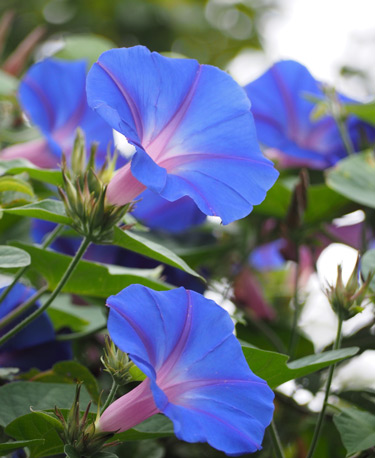
Ipomea indica - Morning Glory

Jasmine polyanthum
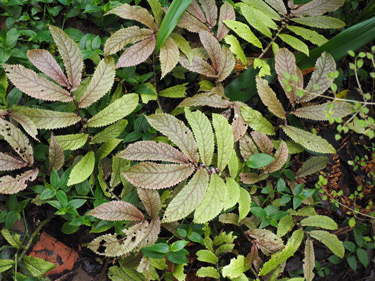
Invasive wandering willie and the much more desirable native ground cover, Parataniwha.
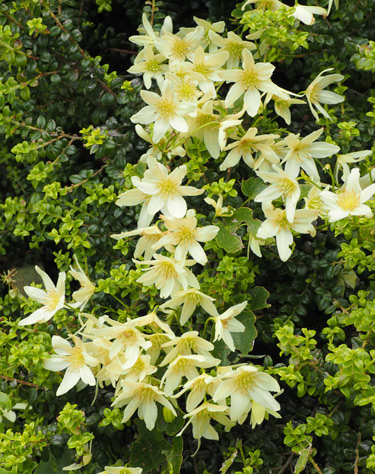
Native Clemtis forsteri growing through Metrosideros.
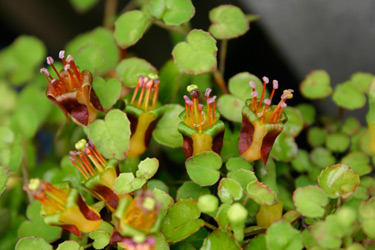
Fuchsia procumbens
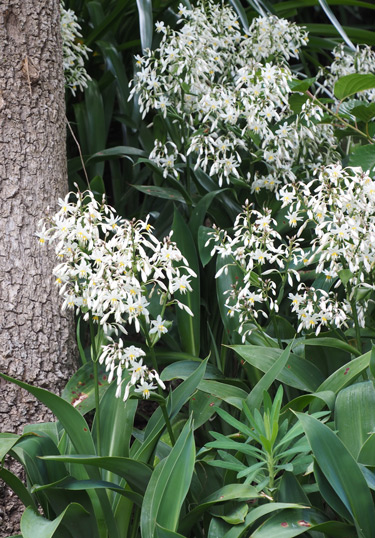
Arthorpodium cirratum, Rengarenga lily

